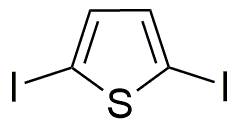2,5-Diiodothiophene is widely utilized in research focused on:
- Organic Electronics: This compound is a key building block in the development of organic semiconductors, which are essential for creating flexible and lightweight electronic devices such as OLEDs and solar cells.
- Pharmaceuticals: Its unique structure allows for the synthesis of various biologically active compounds, making it valuable in drug discovery and development processes.
- Material Science: Used in the formulation of advanced materials, 2,5-diiodothiophene contributes to the creation of high-performance polymers and composites, enhancing their electrical and thermal properties.
- Sensors: This chemical is employed in the fabrication of chemical sensors, particularly for detecting environmental pollutants, due to its sensitivity and selectivity.
- Research in Photovoltaics: It plays a significant role in enhancing the efficiency of dye-sensitized solar cells, providing a more sustainable energy solution.
General Information
Properties
Safety and Regulations
Applications
2,5-Diiodothiophene is widely utilized in research focused on:
- Organic Electronics: This compound is a key building block in the development of organic semiconductors, which are essential for creating flexible and lightweight electronic devices such as OLEDs and solar cells.
- Pharmaceuticals: Its unique structure allows for the synthesis of various biologically active compounds, making it valuable in drug discovery and development processes.
- Material Science: Used in the formulation of advanced materials, 2,5-diiodothiophene contributes to the creation of high-performance polymers and composites, enhancing their electrical and thermal properties.
- Sensors: This chemical is employed in the fabrication of chemical sensors, particularly for detecting environmental pollutants, due to its sensitivity and selectivity.
- Research in Photovoltaics: It plays a significant role in enhancing the efficiency of dye-sensitized solar cells, providing a more sustainable energy solution.
Documents
Safety Data Sheets (SDS)
The SDS provides comprehensive safety information on handling, storage, and disposal of the product.
Product Specification (PS)
The PS provides a comprehensive breakdown of the product’s properties, including chemical composition, physical state, purity, and storage requirements. It also details acceptable quality ranges and the product's intended applications.
Certificates of Analysis (COA)
Search for Certificates of Analysis (COA) by entering the products Lot Number. Lot and Batch Numbers can be found on a product’s label following the words ‘Lot’ or ‘Batch’.
*Catalog Number
*Lot Number
Certificates Of Origin (COO)
This COO confirms the country where the product was manufactured, and also details the materials and components used in it and whether it is derived from natural, synthetic, or other specific sources. This certificate may be required for customs, trade, and regulatory compliance.
*Catalog Number
*Lot Number
Safety Data Sheets (SDS)
The SDS provides comprehensive safety information on handling, storage, and disposal of the product.
DownloadProduct Specification (PS)
The PS provides a comprehensive breakdown of the product’s properties, including chemical composition, physical state, purity, and storage requirements. It also details acceptable quality ranges and the product's intended applications.
DownloadCertificates of Analysis (COA)
Search for Certificates of Analysis (COA) by entering the products Lot Number. Lot and Batch Numbers can be found on a product’s label following the words ‘Lot’ or ‘Batch’.
*Catalog Number
*Lot Number
Certificates Of Origin (COO)
This COO confirms the country where the product was manufactured, and also details the materials and components used in it and whether it is derived from natural, synthetic, or other specific sources. This certificate may be required for customs, trade, and regulatory compliance.


